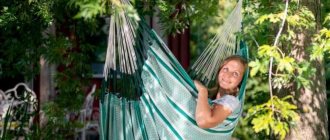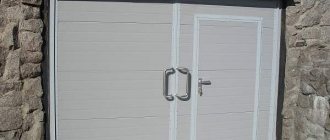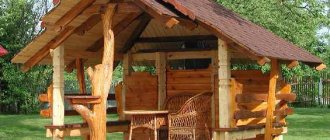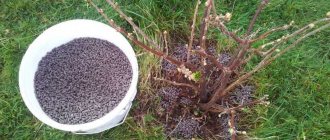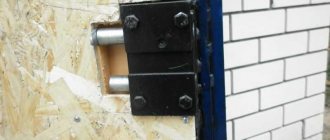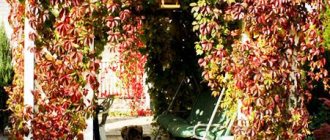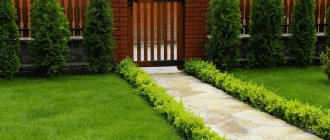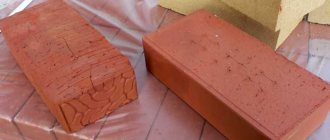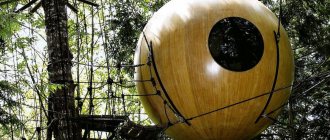LiveInternetLiveInternet
—Categories
- For children (61)
- Training (32)
- games (14)
- Educational toys (9)
- Crafts (4)
- Poems (2)
- Topiary (18)
- Sales organization (13)
- Aphorisms, quotes, proverbs, wise thoughts (3)
- Knitting (2)
- Crochet sweaters (2)
- Wedding accessories (1)
- Video (3)
- Vintage (1)
- Decor (13)
- master classes on decor (11)
- Decoupage (541)
- Inspirello (18)
- Marina Trublina (17)
- Alisa Luchinskaya (47)
- Anna Turchina (24)
- Ascetic (60)
- Bottles (5)
- vases (5)
- Video lessons (42)
- Evgenia Bazhenova (4)
- Elena Perestoronina (45)
- Imitation of various materials (36)
- Craquelure (36)
- kitchen (5)
- Marina Nikulina (15)
- Natalia Rodina (27)
- Natasha Fokhtina (34)
- Christmas balls (66)
- new year (6)
- Polish decoupage (4)
- Watches (3)
- Shabby chic (12)
- Decoupage. For inspiration (122)
- Key holders (1)
- Dressers (6)
- Watering cans (1)
- Miscellaneous (23)
- Decoupage. Materials (56)
- Decoupage. MK (157)
- Bottles (10)
- For the cottage (124)
- Home interior (9)
- gazebos (9)
- flower pots and flowerpots (5)
- Landscape design (55)
- Crafts and garden decorations (35)
- paving slabs and covering (10)
- For the kitchen (4)
- Interior (2)
- Gift ideas (15)
- from coffee (1)
- Interesting sites (9)
- interior (14)
- Pictures for decoupage miscellaneous (336)
- Africa (7)
- Curbs (6)
- Vintage (17)
- Kitchen (25)
- Bears (6)
- Men's (11)
- New Year's (67)
- Birds (3)
- Miscellaneous (82)
- Serial (14)
- Backgrounds (23)
- Floral (71)
- Cardboard boxes (64)
- mk cardboard boxes (54)
- MK matchboxes (2)
- new year (1)
- Training (5)
- English (2)
- Computer (3)
- Newspaper weaving (5)
- Repair (2)
- Scrap kits (953)
- Colors (143)
- Spring (61)
- Tender (43)
- Handicrafts (6)
- Travel (4)
- Vintage (136)
- Children's (217)
- Winter (118)
- Summer (51)
- Marine (40)
- Male (17)
- Autumn (62)
- Wedding (65)
- Scrapbooking (481)
- Albums, books (158)
- Clipart (49)
- Master class (107)
- Men's (28)
- Lettering (48)
- Cards for inspiration (35)
- passbook (12)
- Sketches (24)
- Links (15)
- Scrapbooking.Pictures for printing (194)
- Housekeeping tips (2)
- Bags (8)
- Jeans (2)
- Organizer, storage (4)
- bottle packaging (3)
- gift wrapping (15)
- bows (8)
- lesson on LiRu (38)
- Photos (68)
- photo processing (1)
- programs (13)
- Photography Lessons (26)
- photoshop (27)
- Flowers (30)
- paper flowers (20)
- braid flowers (11)
- Caskets (59)
- MK (39)
—Tags
—Search by diary
—Subscription by e-mail
-Statistics
CONIFEROUS FLOWER BED: 12 SOLUTIONS WITH DIAGRAMS
Coniferous flowerbed: 12 solutions with diagrams
Coniferous flowerbed The main coniferous plants in garden compositions are not tall conifers (pines, spruce, fir), but their compact and low-growing forms. Coniferous compositions go well with shrubs (rhododendrons, Ericas, heathers, barberries, spirea, evergreen boxwoods), herbaceous perennials (hostas, ferns, cereals). When creating a flower bed, it is necessary to plant ground cover plants in the foreground (creeping grass, awl-shaped phlox, sedums, thyme, bryozoans, etc.). Bulbs (crocuses, muscari, low-growing tulips) will bring bright colors in spring. It is very important to think about the arrangement of plants. Groups must be created according to the principle of contrast of shape and color. For example, it is good to emphasize columnar forms with spherical, dense bush and creeping forms, with different types, textures and colors of needles. The needle-like needles of junipers, spruce and pine trees go well with the scale-like needles of thuja. When selecting plants, you should check their maximum height. Coniferous compositions can only be composed of slow-growing and dwarf varietal forms.
12 options for coniferous flower beds
1.
1. Western thuja “Holmstrup” 2. Medium juniper “Old Gold” 3. Mountain pine “Mops” 4. Coastal juniper “Shlager”
Description of garden junipers
There are about 70 species, of which it is recommended to use about 15 for the garden. Externally, representatives of the Juniper genus may have significant differences. Creeping, groundcover, shrub and tree-like forms are found. The height of an adult specimen, depending on the species and varietal, is 0.1-15 m, width 0.5-6 m. The root system is powerful, the tap root goes deep.
The shape of the crown of tall representatives can be columnar, umbrella-like, pin-shaped, in the form of pads, a cone, a ball, or an egg. Ground cover plants form a dense coniferous carpet when planting 2-3 seedlings per 1 m². The needles on one plant can be needle-shaped and scaly, in various shades of green. There are varieties with bluish, gray, golden, brown, and brown colors. The leaves are often collected in whorls of 2-3 pieces.
The flowering of juniper is inconspicuous and occurs through male spikelets consisting of stamens and anthers, as well as female spikelets consisting of scale-like carpels. The decorative value of conifers increases during fruiting. The cone berries are round or elongated, blue, purple or close to black in color, contain up to 10 wingless seeds, and ripen in 1-2 years.
Ready-made schemes for juniper flower beds with other flowers and plants
Chaotic placement of juniper bushes on a site does not give such a visible aesthetic effect as planting according to a special scheme. With different types of flowers, plants and other conifers, juniper bushes create unusual but very beautiful combinations. That is why planting according to special schemes is very popular among gardeners. Juniper looks most advantageous with such “neighbors” as barberry, hydrangea, spirea, thuja, hosta, as well as with various flowers and compositions in flower beds.
How to create a fence from living materials
Choosing seedlings
At your summer cottage, you can see coniferous shrubs in the form of trees, bushes, or even a fluffy carpet covering the entire area. This plant comes in several types. When you choose seedlings, it is very important to take into account all the climatic features in your region.
The following types of juniper are in demand for planting in mid-latitudes:
- Virginia.
- Ordinary.
- Chinese.
- Cossack.
- Scaly.
These types of conifers are not susceptible to rotting and are resistant to all kinds of pests.
Helpful advice! The roots must be in moist soil, and when planting, you must adhere to the rule - plant at a distance of 1-2 meters.
Characteristics of varieties of hedges made of coniferous shrubs
Many people ask the question: “Juniper for a hedge – which one is better to choose?” We will tell you about each type in detail, and you can decide for yourself which type suits you best:
- Common juniper has a conical shape. Green needles in this case reach a height of 10 meters at an average elevation. If you properly care for the hedge, a self-made juniper hedge can live for more than two centuries. These plants are undemanding and can easily saturate the air with a pleasant aroma. Common juniper can grow on moss swamps, heaths, rocky slopes, and sandstones.
In landscape design, this plant is used for decorative arrangement of park areas, local areas and garden plots.
- The coniferous Cossack shrub is a low-growing plant (maximum 4 meters in height) and has green and blue needles and grows very quickly in breadth. The plant is unpretentious to the type of soil and lighting. Such shrubs are distinguished by their high level of frost resistance and drought resistance. The plant quickly grows in width and forms difficult and dense thickets.
This type of juniper has its own characteristics - young plants have needle-like needles, while adults have scaly ones. A distinctive feature is the pleasant aroma from pine shoots crushed in the hands. These are the most unpretentious plants. Cossack juniper is often used both when creating hedges and in solo plantings.
- Virginia juniper can grow up to 30 meters in height, and grows well in an open area of the garden. But there is also a negative side - the lower branches die off over time. This juniper is native to North America. This unpretentious and evergreen plant thrives on stony and rocky soils. The needles are thick, dark green and short.
Plants of this species tolerate pruning well and retain their shape well. But the disadvantage expressed by the exposure of the trunk can be hidden if you plant low-growing shrubs or tall grasses nearby.
- The coniferous scaly shrub is branched, but not higher than 1.5 meters. The plant is frost-resistant, has a pleasant pine aroma and a beautiful bluish tint of needles. Reproduction is possible through cuttings and seeds. Its average lifespan is more than 500 years. It has a wide, creeping crown. The needles themselves are childish and short, no more than 0.8 cm in length.
This type of shrub requires a well-lit place and not very well-drained soil. Does not have high frost resistance. Already in the second year of life it begins to bear fruit and the first cones are already up to 6-7 cm in diameter.
Please note that when purchasing juniper seedlings, you should check the root system. Try to buy only those plants that have a healthy root system.
Disembarkation
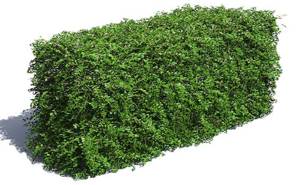
Before planting juniper seedlings, you should tighten the cord. After this, we dig a hole at a distance of two meters; it should be 0.7 meters deep and as wide as the size of a seedling. Juniper hedges should be planted in a checkerboard pattern to minimize the use of soil in the summer cottage.- After this, a drainage layer should be laid at the bottom of the hole, which consists of broken bricks, sand, compost, peat and turf soil. You can buy this mixture at a flower or hardware store.
- When you start planting seedlings, smooth out all the roots and cover them well with soil. After this, a weak solution of potassium permanganate should be poured into the hole to prevent the appearance and development of fungal diseases.
- Plants should only be trimmed in spring. Remove only lateral and dead branches that will extend beyond the formed crown. To trim, use hedge trimmers or regular scissors. In the future, haircuts should be carried out as needed, usually more than 1-2 times a year. For feeding, use any type of nitrogen fertilizer.
- When the hedge reaches the required height, trim the tops to stimulate intensive development of the plant's side shoots.
Advice! If the plant loses the necessary needles, remove the exposed branches. It should be remembered that dying off occurs when there is a lack of sunlight or fungal infection, so try to take care of the plant in a timely manner and prevent the development of the disease.
Juniper and conifers
Planting juniper next to other conifers is a very common practice. The main thing here is to choose the components: the quantity can be arbitrary, the only mandatory condition is the contrast of the colors of the needles and the height levels of the shrubs. When forming a flower bed or garden plot in a cascade, the cone-shaped tall subspecies of juniper bushes are planted first, and then, in descending order, medium-sized and low-growing ones.
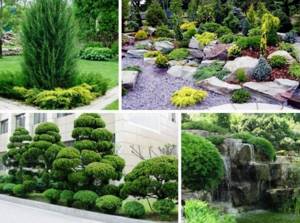
It is also possible to combine several species of juniperus, provided the soil type is suitable (if the species like different acidity of the soil, it will be quite difficult to maintain the composition in a viable state).
Conventionally, all types of layout are divided into:
- landscape (all elements are arranged in a chaotic order - flowers, bushes, trees);
- symmetrical (two or more types of fir trees with the same number of juniper bushes);
- for zoning (example: spruce, thuja, juniper).
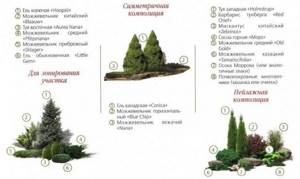
Planting and care
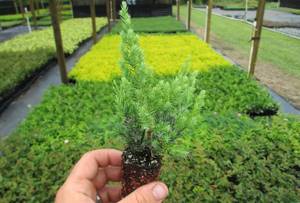
The right time for planting in open ground is mid-spring or autumn. To get a bright color, juniper stricta must grow in a sunny place. Preparing special soil is not necessary, but it is better to grow shrubs in limestone or sandy soil.
Important!
Sprouts that have reached 3-4 years of age are suitable for planting. When choosing seedlings, carefully inspect the juniper for absence of diseases or pests.
During planting, you need to be careful not to touch the soil on the roots, otherwise there is a high probability of reducing the seedling's immunity.
Planting scheme
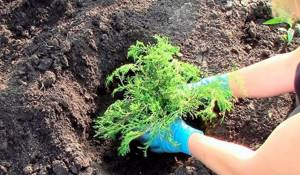
Consider the species characteristics and characteristics of plants:
- Small shrubs are planted in a hole measuring 50x50x50 at a distance of 0.5 - 1 m from other plants.
- Large tree-type juniper should be planted in holes 70x70x70, maintaining a distance of 2 m.
15-20 days before planting, it is necessary to place drainage made of sand and bricks in the ground, and then fill it with soil, peat and compost.
Small juniper sprouts are planted completely in the ground. If the plant is large, after planting it should protrude 7-10 cm.
Watering and fertilizing
Juniper does not require care, so throughout its growth it is periodically watered, fed with fertilizers and pruned.
A few important recommendations:
- water in dry weather at least once every 15 days;
- an adult plant requires 10-15 liters of water at a time;
- for better growth, spraying is recommended once every few days (on days of scorching sun);
- in the spring, fertilize the soil with nitroammophos (50 g per 1 m²);
- in summer it is recommended to add minerals and organic matter once a month;
- pruning is necessary to create a composition in the landscape design.
Formation must be carried out carefully so as not to damage the branches, otherwise growth will slow down by half, and the risks of contracting diseases will increase.
Tips for growing ornamental plants
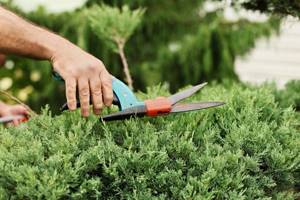
To grow a bright and spreading bush or tree, you must adhere to several rules:
- The planting site should be shaded in the summer. Otherwise, it grows in light areas.
- In hot weather, spray pine needles twice a day.
- When watering, monitor the stream of water so that it does not damage the trunk and branches.
- In winter, the columnar-shaped heather must be tied with twine so that the bush does not deform under the weight of snow.
- To provide protection in winter, use spruce branches for shelter.
Compositions of juniper with thuja
In combination with thujas, other plants, for example, Grandiflora hydrangea, can be planted near juniper bushes. Approximate layout: the Cossack variety (Danub) is planted in the center, and western thujas (Vudvari) are planted on the sides; in the background it is permissible to place cone-shaped thujas of the Smaragd subspecies with needles that are brighter than those of Vudvari.
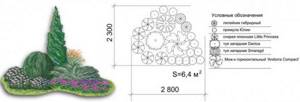
Recommended flowering plants: petunias, jasmine, daisies.
Description of the variety
This plant is single-seeded. Its fruit contains one single seed. Juniper has a high life expectancy. The age of the plant can reach six hundred years.
The most popular are Meyeri scaly and common. Although they look different, the rules for growing them are the same. They are characterized by the fact that they do not require special care.
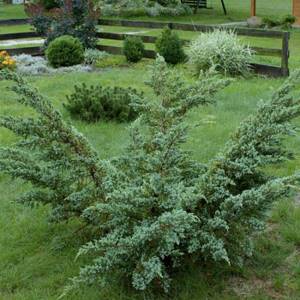
Juniper Meyeri
Varieties
There are two main varieties of the variety: common juniper or scaly juniper.
The first of them can reach a height of 4 meters, its crown diameter is one and a half meters. Has a high growth rate. It has high resistance to polluted air.
Juniper scaly Meieri does not exceed one meter in height. It grows in breadth.
History of the variety
The Meyeri juniper is native to the mountains of China, Taiwan and Afghanistan.
Appearance
The height is usually from 50 cm to 1 m for the scaly variety and four meters for the regular one. Growth occurs relatively quickly - in a year the Meyeri juniper gains about 10 cm.
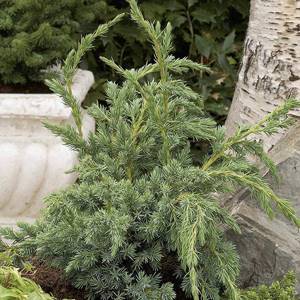
Juniper Meyeri
One of the features of the appearance of this variety is the presence of pointed and awl-shaped juniper needles. Their color can be gray or blue-green. There are three of them in each whorl. On each of them you can easily see a longitudinal, narrow, silver stripe. The length of the needles ranges from 6 to 10 mm.
Plant shape
The shoots of the juniper scaly Meyeri are drooping, they spread along the surface of the ground. Height - no more than a meter above the surface. It grows in breadth, covering the ground with a thick crown.
The common juniper variety Meyer is a tall plant. An adult specimen reaches four meters in height and one and a half meters in width.
Juniper with hostas
Hostas with shrubs form a so-called contrasting flower garden. They usually occupy the extreme part of the diagram. Shape: circle, cascade, oval. Virginia juniper is suitable for combination with hostas, as well as Japanese astilbe, cappuccino astilbe, barberry, heucherella, and iris. Planting along the perimeter of the site with spruce and cypress trees is allowed. Recommended flowering plants: daffodils, tulips, all bulbous plants.

They usually occupy the extreme part of the diagram.
Juniper and barberry
This combination may also contain other shrubs and plants, for example, thujas or pine trees. When choosing varieties, people most often pay attention to Thunberg barberry, rocky (Skyrocket) and medium juniper (Mint Julep). The number of elements in a flower bed is usually 5, 6 or 7. Larger plant compositions are used when designing large areas. Recommended flowering plants are rhododendrons, hydrangeas, primroses.
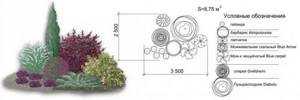
Designers recommend giving preference to dwarf barberries, for example, Arthropurpurea Nana, Harlequin, Kobold, Minor, Aurea. They have a denser crown and are characterized by slow growth.
Diseases and pests: prevention and treatment
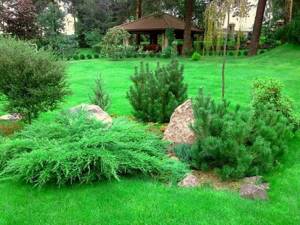
Juniper is an unpretentious plant that does not require frequent watering or special soil. It easily withstands sudden temperature changes and easily tolerates dry and humid weather. It grows well both in sunny areas and in the shade, but, despite all of the above, the plant is not resistant to diseases and parasites.
Table of possible diseases
| Disease | Description | Treatment and prevention |
| Branch cancer | A distinctive characteristic of the disease is the appearance of cankers on the branches, which contributes to drying out, as fungus forms in them | If the disease progresses, it is necessary to remove the damaged areas and treat the sections with a mixture of copper sulfate and Bordeaux mixture. You can replace the solution with the preparations “HOM” or “Abiga-pik”. For prevention, Bordeaux mixture is used, pouring it under the root as soon as the snow melts |
| Cortical necrosis | During the defeat, the branches suffer, reddish growths appear on them, which over time become black, which leads to the preservation of the plant | For treatment and prevention, the same methods are used as for cancer of the branches |
| Rust | Features of the disease development in damaged areas of thickenings. Ulcers will form at the roots and throughout the trunk, which will lead to the death of the plant. | Copper sulfate and Bordeaux mixture are used as treatment. But the procedures help only in the initial stages |
| Schutte or brown chickenpox | Development begins in the spring; on diseased branches the needles turn yellow and dry | To prevent the spread, remove dried branches in a timely manner and do not forget to carry out preventive treatment of plants in the spring with the “Hom” preparation and autumn prevention with the “Abiga-pik” preparation. |
| Fusarium | The disease begins to develop in the roots. Due to active distribution, beneficial substances stop reaching the top, which contributes to drying | It is impossible to cure the plant. To avoid spreading to other bushes, infected plants need to be dug up and those growing nearby should be treated with Baktofitol or Vitaros. |
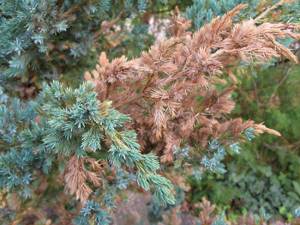
Insects and other parasites are no less dangerous diseases, so the fight against them must also be active.
| Pests | Description | Elimination |
| Aphid | Appears on young plants. The pest sucks out the sap of the heather, making it weak. This leads to growth delinquency and an increased likelihood of contracting the disease. | To get rid of parasites, water the damaged plant with a solution of laundry soap and cold water. Repeat this action once a week until the pest is completely eliminated. |
| Shchitovka | Insects are active on ripened fruits, but they appear on needle-shaped leaves. They feed on the sap of rock juniper, which causes the shoots to become deformed and the plant to die. | To get rid of scale insects, in the spring they cover the trunk of the plant with caterpillar glue, and lay a circle of straw around it. If signs of damage become noticeable, the parasites must be removed manually using a blunt object |
| Gall midges | The parasites are completely invisible, their length reaches 2 mm. They do not cause harm, but noticeably slow down the growth and spoil the appearance of the juniper | To eliminate it, it is recommended to treat the plant with insecticides and remove the affected areas. |
| Mite | If the parasite appears, the plants become covered with cobwebs, which resemble yellow spots, causing the needles to dry out and fall off. | When symptoms become noticeable, treat the affected areas with sulfur or garlic infusion. In case of extensive damage, use an acaricide |
Important!
Make sure that the mixture of Bordeaux and vitriol (and some drugs) does not get into the roots; to do this, cover the soil with film. Read the instructions carefully before handling.
Timely prevention and treatment allows you to maintain the attractiveness of the heather.
Rectangular high flowerbed with spirea
This type of flower bed can be presented in several variations:
- a high stone container (marble, granite) with sides, inside of which earth is poured and juniper, other conifers and spirea are planted on it;
- a structure made of stone and mesh with an earthen “cushion inside”;
- a classic rectangular flowerbed located on a hill and fenced off by a fence;
- composition along a fence or garden path.
Of course, there are plenty of options. The general rule for all such schemes is that low grades are placed at the edges, higher ones in the depths. This principle also applies to cascading garden design solutions. Varieties of spirea for combination with juniper: Nippon, gray, birch-leaved, Vangutta.
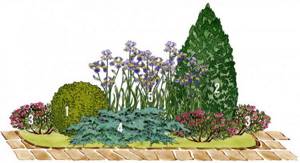
1. Thuja occidentalis “Globosa” 2. Cypress pea 3. Spiraea Boumalda “Froebelli” 4. Scaly juniper “Blue Сarpet” 5. Hybrid iris.
By following the rules for forming flower beds and landscape compositions, you can get a truly spectacular garden decoration. Designers call the best color combinations yellow-green, yellow-white, emerald-lemon, as well as combinations of pine needles with red, purple, yellow and orange flowering plants.
Pros and cons of use
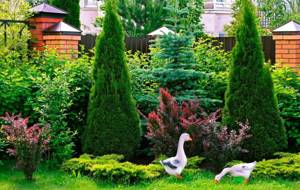
There is no substitute for juniper in the landscape design of parks and gardens due to a number of advantages:
- long lifespan;
- high survival rate;
- wide variety of colors and shapes;
- the ability to create a bright color accent;
- easy care;
- crown formation every season is not required;
- does not attract the attention of wasps or bees;
- They can easily tolerate cold and hot weather.
There are no dwarf creeping plants with similar characteristics and appearance, and there are no disadvantages to using them.
Schemes of flower beds with coniferous plants
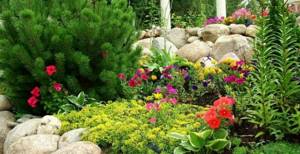
Many gardeners try to create a beautiful flower bed in their own dacha without resorting to the services of landscape designers. Of course, this not only saves money, but also has a beneficial effect on our self-esteem, and also satisfies the creative impulse of “country designers.” If you don’t have enough ideas for inspiration, I offer a selection of flower bed planting schemes using coniferous plants to help.
Mixed compositions with foliage plants
Coniferous plants are beautiful in themselves, but they can sparkle with new colors if you combine them in one composition with deciduous plants. They will serve as an excellent backdrop for beautifully flowering deciduous plants - roses, rhododendrons, hydrangeas. Here, endless space opens up for your design imagination, because the palette of colors and textures in such mixes expands significantly.
***
Thanks to the huge variety of shapes and colors, coniferous plants make excellent compositions that will attract the eye for a long time. And if you consider that they retain their decorative properties throughout the year and look even more elegant under the snow caps, you should definitely try to create at least a small coniferous corner on your site.
We are on social networks: Feel free to join groups, write comments, read and discuss daily articles on social networks!


